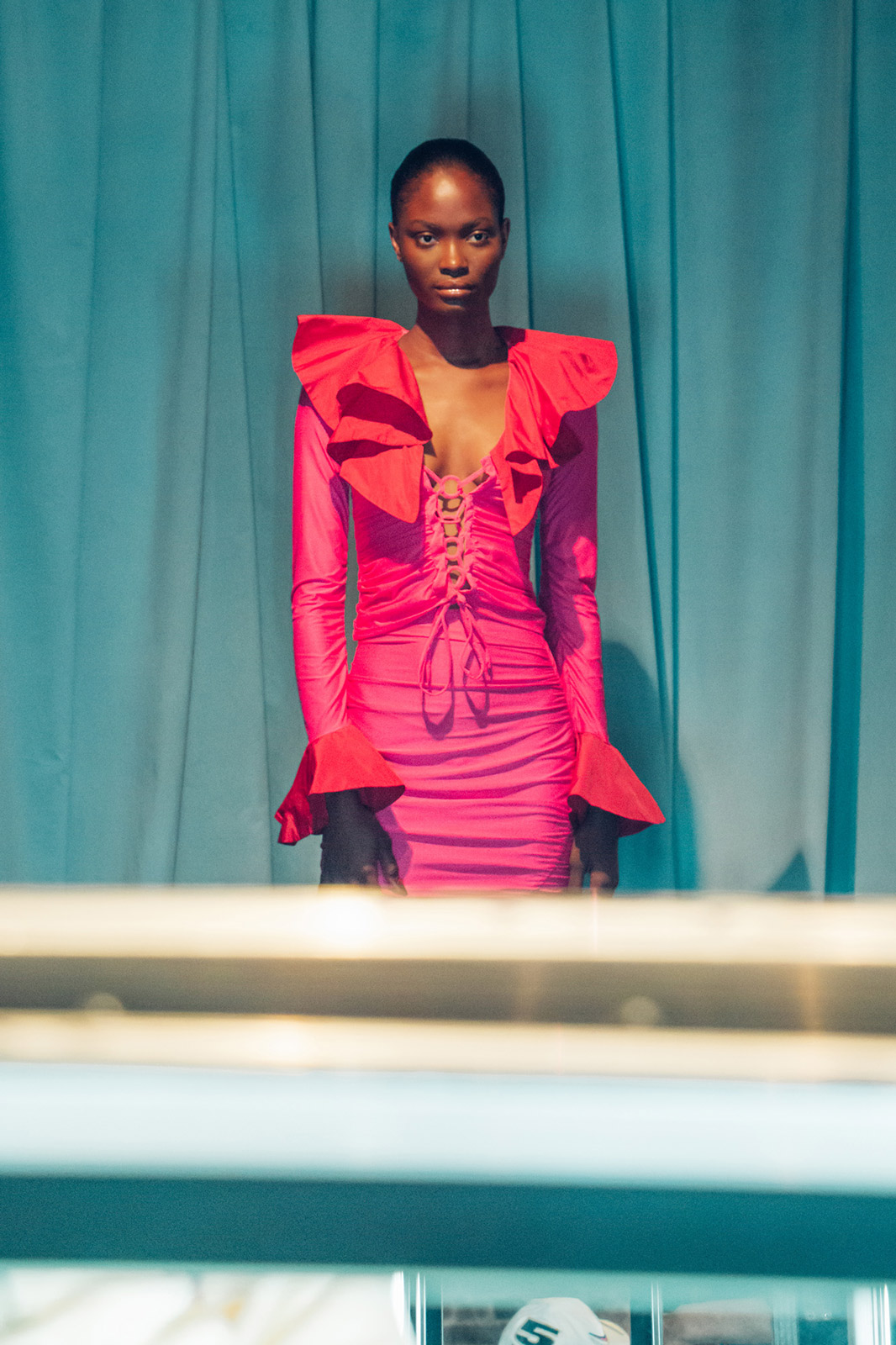Following her standout London Fashion Week show, the designer breaks down the makings of her complex vision, from beading to deadstock to Lauryn Hill
For Fall/Winter 2023, Priya Ahluwalia was concerned with more than just the visual. She was thinking about what her namesake brand might sound like, drawing from the music that permeated her London upbringing—“Lauryn Hill and Sade and Missy Elliott and 50 Cent,” spliced with Fela Kuti and Bollywood soundscapes. “I was thinking about how their performance and their art have inspired me as a creative, in both fashion and film,” she says.
The resulting presentation, titled Sounds of Ahluwalia: Passport to Freedom, was the designer’s most personal foray into the London fashion scene thus far, drawing from her upbringing, her heritage, and her philosophies as an interdisciplinary artist. The collection spanned animal print and beaded embroidery, the skin-tight and the billowing, red-carpet gowns and all-denim ensembles, across an anything-goes palette. “I was able to create looks that are really my vision,” says the designer, “from head to toe for the first time.”
Here, Ahluwalia reflects on the makings of her standout show, from its sourcing, to its staging, to its unforgettable score.
Morgan Becker: Tell us about your earliest memories associated with clothing and design.
Priya Ahluwalia: I’ve always wanted to be a designer. I remember being in primary school, reading all my mum’s fashion magazines. I loved watching music videos and looking at all the fashion there. I was always drawing outfits and designs. It’s quite funny when I see my friends from [back then]; they always say that they remember me being obsessed with clothes, and really into style.
Morgan: How does your heritage factor into your design philosophy?
Priya: A big part of my design philosophy is to amplify and celebrate my dual Indian and Nigerian heritage, and my London roots. I am constantly researching diaspora, whether [through] film, music, art, architecture. I use the brand as a vessel to learn more about where I am from—especially because, going to school in London, I had a very Western education.
Morgan: You work with a lot of deadstock and vintage materials. Where do you source it, and what do you look for in something to potentially repurpose?
Priya: Sometimes it’s from UK wholesale vintage places. [Other times] its suppliers in India, Portugal, Italy—it comes from all different places. The process of sourcing has developed since the brand has gotten bigger. Initially, I was able to find really unique and one-off things, but now we need to think about scalability. Denim, for example, is a good thing to repurpose, because it’s easier to get lots of it.
Morgan: Tell us about this collection. What is its uniting factor, or the narrative behind it?
Priya: Symphony is informed by my journey with music, and the music that has inspired me since I was a child—Lauryn Hill and Sade and Missy Elliott and 50 Cent. I was thinking about how their performance and their art have inspired me as a creative, in both fashion and film. I looked into the music itself, [the songs’] sound waves, flyers from concerts—a myriad of things that created the collection.
Morgan: What about its process was the most gratifying?
Priya: I feel like we have leveled up in so many areas. I am proud of the show; it was [staged] in a beautiful concert hall with a live score, with a saxophonist and pianist. It was a special moment that felt really 360. We introduced a wider product range—shoes for the first time and belts, and more outfits that are inspired by and intended for people doing shows and on the red carpet. I was able to create looks that are really my vision, from head to toe for the first time.
Morgan: How would you characterize the London fashion scene?
Priya: It is definitely a place that nurtures new talent. Emerging designers are given freedom to breathe here, and to be heard and seen. Like everywhere in the world, it is also quite hard—in terms of the economy, COVID, [and so on]. But I still think it is a really exciting powerhouse for creativity.
Morgan: What are you hoping to impart to the audience at your show?
Priya: I wanted people to go on a journey with me. Maybe they would recognize elements of the soundtrack. Maybe they would see a look and be like, Oh my god, I would love to wear that somewhere. I wanted [the show] to evoke both imagination and nostalgia in the audience. Obviously, I wanted people to fall in love with the clothes. I have ideas on what things should sound like, what they should look like, what they should feel like—and I think this show is a real stepping stone in that direction.



















